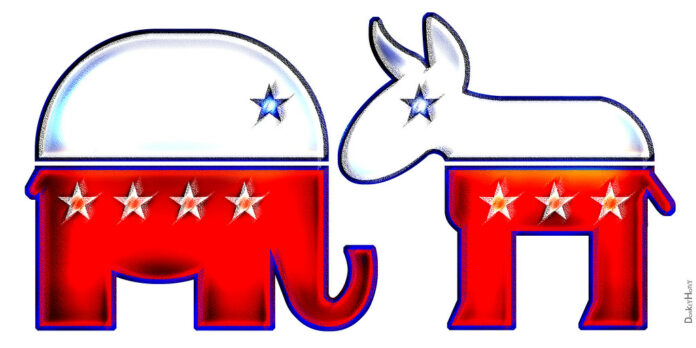Democrats, Republicans and the battle for the soul of America
At the Republican National Convention in 1992, the controversial conservative political commentator Pat Buchanan declared that the country was in a “struggle for the soul of America.”
Just a few months earlier, Buchanan was on the offensive, leading a populist attack against the same reigning president he was now endorsing: George H.W. Bush. The paleoconservative insurgent had hit Bush Sr. from the right, utilizing a platform of fair trade, immigration reductionism and opposition to multiculturalism. This led to surprise showings in states like New Hampshire and Georgia. Buchanan eventually dropped out and endorsed Bush, but not before first provoking a conversation about the ideological identity of the Republican Party.
Nearly three decades later, the Republican Party now finds itself once again engaged in a battle for the soul of America, faced with the same debates that shook their party’s core in ‘92.
Starting with the election of President Donald Trump in 2016, the Republican Party’s voter demographics began to transform, bringing a gradual leftward shift in fiscal policy. Trump, who has at times opted toward the Republican tradition of corporate tax cuts, initially ran on a theme of trade protectionism and economic nationalism, vowing to transform the GOP into a “worker’s party.”
Republican support since then has become increasingly centered around the white working class, capturing a segment of the population that was traditionally regarded as part of the swing vote. The Democratic Party, meanwhile, has continued to utilize a broader coalition of different minority groups while also bringing new demographics to its fray. Democrats are now finding support in a considerable number of older, upper-class whites — a former key constituency of the Republican Party — as well as younger, liberal white voters (a majority of whom actually hold more radical views of race and inequality than their black and Hispanic counterparts).
The ongoing economic crisis provoked by the outbreak of the COVID-19 pandemic has accelerated this new ideological split. Republicans are now increasingly finding themselves to be the non-college-educated white-people party. Because of this, they have essentially doubled down on social conservatism while maintaining a slow approach to abandoning the free-market fundamentalism, once advocated for by deficit hawks like Paul Ryan and Mitt Romney.
When the prospect of direct cash payments to American citizens initially arose, it was largely Republicans leading the charge. Ironically, the aforementioned Romney was the first Republican at the helm, calling for a $1,000 dollar payment to every American adult. This action was further contrasted by conservative suggestions coming from Senate Democrats, like Kamala Harris who proposed a mere $500-per-adult payment. And now, once again, President Trump appears to be flirting with the idea of expanding healthcare coverage, flanking a large portion of the Democratic Party from the left.
The divide between fiscal conservatives and renegade populists in the Republican Party has also trickled down to the college level. In California, conservative students are dealing with a major fracture in the organization of collegiate groups. Traditional, establishment-based California College Republicans have seen chapter organizations disband and join the California Federation of College Republicans, a coalition of nationalist, largely pro-Trump student organizations.
The thought of the campus conservative no longer conjures up the image of the principled Reaganite. Instead, it produces a picture of a much more provocative variety of right-wingers.
Although establishment Republicans and free-market advocates have good reason to fear this ideological transformation, Democrats should as well. Even with the country’s rapidly transforming population demographics working in the latter’s favor, the majority of Americans still oppose perceived political correctness and a huge portion of the national constituency, especially swing voters, continue to identify as economically progressive and socially conservative. This group previously didn’t have any sort of meaningful political representation — now that’s changing.
This could spell doom for the Democrats, many of whom have opted to embrace broad appeals to identity, which remain largely unpopular outside of college campuses and progressive think tanks.
Indeed, it was Joe Biden, the least socially progressive of the Democratic presidential candidates, who was able to capture the key Democratic primary constituencies of older African-American and white, working-class voters. Those two groups remain relatively socially conservative compared to their younger party colleagues.
The future of the American soul thus belongs not to those who double down on their strict adherence to ideology. It instead belongs to whichever party first manages to adopt a pragmatic approach, appealing to the highly popular but lightly represented socially conservative, fiscally progressive voter.
Written by: Brandon Jetter — brjetter@ucdavis.edu
Disclaimer: The views and opinions expressed by individual columnists belong to the columnists alone and do not necessarily indicate the views and opinions held by The California Aggie





Good piece. Thoughtful, well written, and not saddled with your own personal ideological baggage.